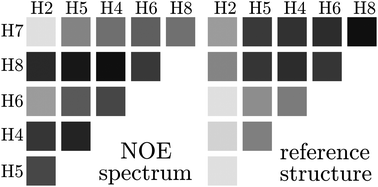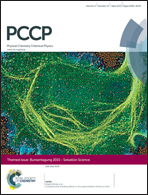The intermolecular NOE is strongly influenced by dynamics†
Abstract
The intermolecular NOE in NMR spectroscopy is analyzed theoretically via computer simulation. Our test case is the homonuclear NOE between hydrogens in the ionic liquid 1-ethyl-3-methylimidazolium trifluoromethanesulfonate. A coarse-grained model of this system is developed and simulated in a 3 microseconds molecular dynamics run, subsequently used for analysis. Our findings are the following: Spin pair specific dynamics has a strong influence on the spectrum. As a consequence, structural information cannot be read off directly. Instead, different contributions to the signals must be disentangled before one can gain information about structure. We show that the extent of signal distortion through dynamics correlates with the spins' distance to their respective molecular centers of mass. Since we deal with pair distributions of spins, the extracted structure does not represent average distances between two spins but the sum of the influence of surrounding spins. In fact, we find that this influence is long-ranged. Our data explicitly shows that the usual 1/r6 dependence is replaced by a distance dependence between 1/r3 and 1/r. However, structural information consists of a spin pair specific short-ranged contribution and a uniform long-ranged contribution. The transition from specific to uniform is sensitive to the behavior of the underlying pair distribution functions.

- This article is part of the themed collection: Bunsentagung 2015: Solvation Science

 Please wait while we load your content...
Please wait while we load your content...